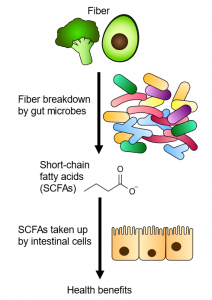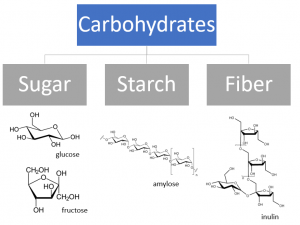By Jeffrey Letourneau
What did you eat for dinner last night? It might feel like a long time ago from your perspective, but chances are that the microbes in your gut are currently digesting some of the last remaining nutrients from that meal. In particular, dietary fiber is an important food source for these microbes, and it’s in our best interest to keep them well-fed.
So, what’s so special about fiber? Fiber is a type of carbohydrate, a class of molecules made of carbon, hydrogen, and oxygen atoms. The simplest type of carbohydrate is a monosaccharide, or simple sugar. You’ve probably heard of fructose and glucose, for example. These monosaccharides can link up in different ways. Combine one fructose and one glucose and you get sucrose, or table sugar. Combine hundreds of glucose molecules in a chain and you get starch. The human body has 17 genes devoted to breaking down these complex carbohydrates. While that may sound like a lot, it ultimately means that we can only get energy from starch, sucrose, and lactose. Dietary fiber then, is just any type of carbohydrate that our body can’t digest on its own.
Now, let’s say you eat a banana. It contains starch, sucrose, fructose, and glucose – all of which your body can use – but it’s also relatively high in inulin, a complex carbohydrate made of many fructose molecules with a single glucose stuck on the end. Our human cells can’t break inulin down, so it travels through the digestive tract intact until it reaches the gut microbiome in the small and large intestines.
 The human body is home to many trillions of bacteria and other microbes; by some estimates, these microbes outnumber our own cells. And the gut is like the rainforest of the body, a site with more microbial diversity than everywhere else in the body combined, with around 100 billion bacteria crammed into each gram of intestinal contents. Collectively, these bacteria have over 15,000 different genes for breaking down complex carbohydrates. Makes our 17 sound pretty pathetic, huh?
The human body is home to many trillions of bacteria and other microbes; by some estimates, these microbes outnumber our own cells. And the gut is like the rainforest of the body, a site with more microbial diversity than everywhere else in the body combined, with around 100 billion bacteria crammed into each gram of intestinal contents. Collectively, these bacteria have over 15,000 different genes for breaking down complex carbohydrates. Makes our 17 sound pretty pathetic, huh?
In case you don’t think maintaining the vast microbial diversity of the gut is reason enough to eat fiber, it might help to know that our bacteria feed us too. As they break down fiber, bacteria produce chemical end products including a class of compounds called short-chain fatty acids (SCFAs). While our body can’t use fiber itself for energy, it can use SCFAs that are absorbed back into the cells of our intestines. So by feeding our gut microbes, we are keeping our intestines fed as well. It makes sense, then, that people who eat more fiber have a decreased risk of colon cancer. But feeding our gut microbes has health benefits outside the gut as well. People who eat more fiber also tend to have lower cholesterol, decreased risk of certain infectious diseases, and perhaps even improved cognition.
It’s worth noting that 95% of Americans do not meet the recommended minimum dietary fiber intake. The typical American diet favors a lot of meat and processed foods at the cost of high-fiber foods like fruits, vegetables, beans, and whole grains. It can be very challenging to eat enough fiber, even for people like me who literally study it for a living. But our gut microbes do a lot for us, so next time you’re hungry, thank your microbes by having an extra serving of broccoli or trying a new vegetable. They might show their appreciation by giving you gas, but it will be worth it for your health in the long run.
Edited by Priya Stepp and Alan Curtis

